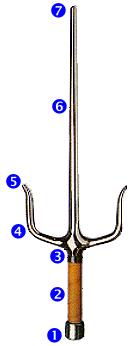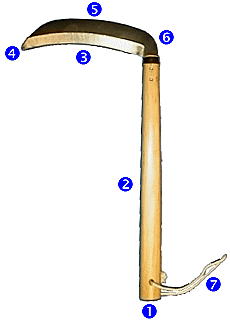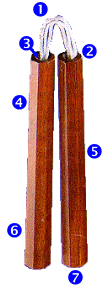
Sai: Iron truncheon (+ Jutte, + Nunte)
Again, the saï was a simple farm instrument which the peasants turned to
their advantage. The Sai is believed to have originated from basically nothing
more than a pitchfork. As a weapon, it was used in conjunction with various
karate stances and techniques, and in defense against sword attacks. Usually,
the saïs are used in pairs. A third saï was hidden in the obi (belt) and was
used to replace one saï that was thrown at the charging enemy. If the throw was
successful, the fight could be over all at once. If not, the distraction could
be just enough to get close to stab with the saï or to counter an attack and win
the battle.The efficient use of the weapon is much reliant on the dexterity of
the practitioner with his thumbs, which the tang is balanced and rotated on
along with the loosening and tightening of the grip from the small finger for
striking and consolidating power. The early use of the weapon makes the user
appear stiff and robotic but as the training advances the flow and unity with
body movement becomes ever more apparent. Sai is the practice of “Shuto” in
empty hand and emphasizes the need for “Koshi no Chikara” (Hip power) and “Suri
Ashi” (sliding movement). The importance of body movement and good footwork is
ever more apparent as the weapon is of a smaller classification than Bo.
Advanced practitioners must learn to throw the Sai, a difficult requirement in
view of the weight. The Sai explores the weakness of Bo, thus making Bo-jutsu
stronger.

1. TSUKAGASHIRA - Butt End
2. TSUKA - Grip
3. MOTO - Wing Base
4.
YOKU - Wing
5. TSUME - Wing Tip
6. MONOUCHI - Shaft
7. SAKI - Tip


Rokushaku Bo: (Kon)
The Rokushaku bo
(staff)(also called Kon in Okinawa), or stick is probably one of the first
weapons that mankind used to defend or hunt. It could easily be found, was not
to difficult to handle, and could be used for multiple purposes. In Okinawa, the
bo probably originated from a farmtool called tenbin. It is a stick held across
the shoulders, on which fish or waterbuckets could be hung. It could also be
originated from walking sticks monks used to ease hiking and eventually defend
themselves. The techniques executed with the bo, were probably developed very
early in history, and were probably refined after the Heian Era (around 1127
AD). Its length is 6ft, or as is sometimes customary, cut to the height of the
user. The wood used is usually Red Oak or White Oak and the Bo is tapered from
the tip ends for better blocking and smoother usage. The weight is dependent on
the wood used and is a critical factor for students, too heavy and the
techniques become cumbersome, too light and there is not enough power. The
weapon is classified as a synthetic one and attracts the greatest distance
training between opponents. It magnifies the areas of development needed with
empty hand and encourages Tai Sabaki/Yoko Sabaki at all times. The practitioner
is taught to hold the weapon initially divisible by thirds and then openly
encouraged to develop a more flexible holding style allowing full use of the
weapons potential distance . . The most common Bo type today is round with
tapered ends. Other types include round non-tapered, octagonal and
square.

1. KONTEI - End 2. CHUKON BU - Middle 3. KONTEI - End

Kama: Sickle (+ Kusarikama) The Kama is the
only bladed weapon of the 5 systematized weapons.The kama was a tool used to cut
weeds and bring in the crop.It was a very simple but very sharp and potentially
deadly weapon.Its structure however made it very weak when attacked with heavy
blows directly to the blade.Therefore,there has been a redesign of the
weapon,which is called natagama.It is stronger in its construction,because the
blade runs through past the curve of the normal kama and all the way down into
the handle. This makes the cutting edge bigger and above all,the previous weak
point where the sickle was attached to the stick has disappeared. The weight of
the shaft is dependent upon the strength of the user and should be tapered to
the butt end with increasing thickness. This allows for ease of catching and
sliding when changing grip. The blade should add sufficient weight to ensure it
is the heaviest point in the weapon. This also allows for ease of usage. The
length of the weapon should extend to about 3cm passed the elbow when held in
reverse grip. The handling of the weapon is the same as the Sai with the
following grips, “Honte-Mochi” (Natural), “Gyakute-Mochi”(Reverse) and
“Tokushu-Mochi”(Special grip). Kama is the practice of “Kuride” and “Kakede”
(hooking and gripping) in open hand technique Often attaching a chain or rope to
the base for greater reach. This longer weapon was known as a kusarigama.

1. SOKO - Bottom
2. NIGIRI - Grip
3. HA - Edge
4. KISSAKI -
Tip
5. MUNE - Spine
6. KASHIRA - Head
7. HIMO - Rope

Nunchaku: Mace, two sectional staff, Horse bit
As all other okinawan weaponry, the origin of this weapon is obscure.
Some say it has a Chinese origin, others say it was developped from a horsebit,
but it seems like it was used by peasant to beat the rice. It probably came into
action somewhere in the 16th century, like saï, tonfa, etc. The nunchaku is made
out of 2 sticks, usually some hard wood, and connected with a rope (it used to
be a horse tail hair) or a chain. As the sticks vary in length, size and weight,
so does the length of the connection between the two sticks. The nunchaku stick
is normally as long as the forearm but it is up to your personnal favor to make
it as long as you want. The sticks could be used for spearing or striking, and
the horse hair rope could choke , block, or trap. The shafts vary from octagonal
to round in shape and the weight is dependent on the strength of the user. Again
too light and there is no power, and too heavy and the movement is slow and
ponderous. Traditionally this weapon is not used in pairs, as the actions of the
one should be sufficient. The grips are similar to that of the Sai in name,
Honte-Mochi” (Natural), “Gyakute-Mochi”(Reverse) and Tokushu-Mochi”(Special
grip). The special grip falls into “Ippon-Tsuki” (single thrust) and
“Tatami-Tsuki” (folding thrust). Nunchaku belongs to the family of Bo and is
known as the “portable Bo”.

1. HIMO - Rope
2. KONTO - Top
3. ANA - Hole
4. JOKON BU - Upper
Area
5. CHUKON BU - Middle Area
6. KIKON BU - Lower Area
7. KONTEI -
Bottom

 History of SHOTOKAN WEAPONS
History of SHOTOKAN WEAPONS
